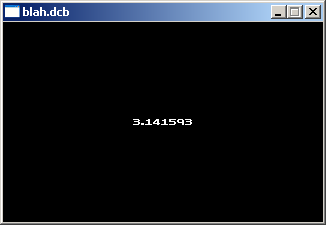- This wiki is out of date, use the continuation of this wiki instead
Write float
From FenixWiki
(Difference between revisions)
| Revision as of 19:31, 24 July 2007 (edit) Rincewind (Talk | contribs) (New Article) ← Previous diff |
Current revision (00:13, 15 November 2007) (edit) (undo) Sandman (Talk | contribs) m |
||
| Line 23: | Line 23: | ||
| '''INT''' : [[TextID]] | '''INT''' : [[TextID]] | ||
| {| | {| | ||
| - | | | + | | -1 || - Error. |
| |- | |- | ||
| - | | | + | | >=0 || - The [[TextID]] of the text. |
| |} | |} | ||
| Line 36: | Line 36: | ||
| == Errors == | == Errors == | ||
| - | + | {| | |
| + | | Too many texts onscreen || - There are too many texts on the screen. | ||
| + | |} | ||
| == Example == | == Example == | ||
| <pre> | <pre> | ||
| Program test; | Program test; | ||
| - | + | Private | |
| - | | + | float my_float=3.14159265; |
| - | + | ||
| Begin | Begin | ||
| - | | + | |
| - | | + | write_float(0,320/2,200/2,4,&my_float); |
| + | |||
| + | Repeat | ||
| Frame; | Frame; | ||
| - | | + | Until(key(_ESC)) |
| + | |||
| End | End | ||
| </pre> | </pre> | ||
| - | This will result in something like:<br | + | This will result in something like:<br> |
| [[Image:Write_float.png]] | [[Image:Write_float.png]] | ||
Current revision
Contents |
[edit] Definition
INT write_float ( <INT fontID> , <INT x> , <INT y> , <INT alignment> , <FLOAT POINTER var> )
Writes a floating point variable to the screen, which will be automatically updated when the value of the variable changes. The floating point variable will remain on the screen until deleted with delete_text().
[edit] Parameters
| INT fontID | - The FontID of the font to be used for the text. |
| INT x | - The X coordinate of the text. |
| INT y | - The Y coordinate of the text. |
| INT alignment | - The type of alignment. |
| FLOAT POINTER var | - A pointer to a floating point variable. |
[edit] Returns
INT : TextID
| -1 | - Error. |
| >=0 | - The TextID of the text. |
[edit] Notes
There is a limit of 511 texts to simultaneously exist on the screen. The program will crash with an error when this number is reached.
The text depth can be changed by adjusting the global variable text_z.
Instead of write_float(), write_var() can be used for the same purpose, which is a more general function that allows you to write variables of any type to the screen.
[edit] Errors
| Too many texts onscreen | - There are too many texts on the screen. |
[edit] Example
Program test;
Private
float my_float=3.14159265;
Begin
write_float(0,320/2,200/2,4,&my_float);
Repeat
Frame;
Until(key(_ESC))
End

